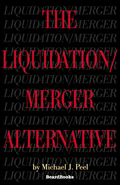|
|
|
|
||||||

|
The Liquidation/Merger Alternative
By Michael J. Peel 2003/01 - Beard Books 1587981572 - Paperback - Reprint - 204 pp. US$34.95 Peel has written a penetrating analysis of numerous determinants and has assembled an impressive bibliography, making this book essential reading for the serious student of financial management and the entrepreneur faced with making merger decisions. Publisher Comments This scholarly book provides a rationale as to why specific companies that appear to be on the brink of corporate collapse are taken over rather than entering into receivership or liquidation. When this study first appeared in 1990, the bankruptcy/merger alternative had received scant attention in published commentary. This book helped to fill the gap by providing new empirical evidence for the UK corporate sector as well as a number of statistical models to investigate whether it was possible to discriminate between "distressed" acquired firms and ones that failed. From the back cover blurb: This scholarly, well-documented book provides a rationale/theory as to why specific companies that appear to be on the brink of corporate collapse are taken over rather than entering into receivership or liquidation. When this study first appeared in 1990, the bankruptcy/merger alternative had received scant attention in published commentary, particularly in the domain of empirical research. The Liquidation/Merger Alternative helped to fill this gap by providing new empirical evidence for the UK corporate sector an a number of statistical models to investigate whether it was possible to discriminate between "distressed" acquired firms and ones that failed. The author has written a penetrating analysis of numerous determinants and assembled an impressive bibliography, making this book essential reading for the serious student of financial management and the entrepreneur faced with making a merger decision. From Book News: Peel (financial management, Cardiff University, UK) provides a theory on why specific companies that appear on the brink of corporate collapse are taken over rather than entering into receivership or liquidation. The book will be of interest to students of financial management and to entrepreneurs faced with merger decisions. The book was originally published in 1990 by Avebury. Annotation (c)2003 Book News, Inc., Portland, OR From Amazon.Com: This is a reprint of a previously published book. It deals with providing a rationale as to why some companies that appear to be on the brink of corporate collapse are taken over rather than entering into receivership.
|
||||||||||||||||||||||||||||||||||||||||||||||||||||||||||||||||||||||||||||||||||||||||||||||||||||||||||||||||||||||||||||||||||||||||||||||||||||||
|
|
|
home
| about us
| contact us
| related
sites |